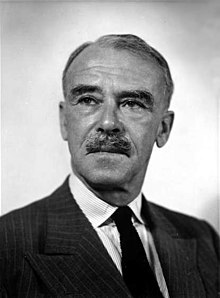Australian ufology
However, the Kenneth Arnold case (June 1947) and the Roswell UFO incident (July 1947) became international press items and appeared in Australian newspapers.
[1] The first gathering of UFO enthusiasts occurred in Melbourne in March 1949 at the Federal Government's newly established Aeronautical Research Laboratory (ARL).
[2] The minutes of the non-government meeting show an attendance of 23 enthusiasts from various state and local groups such as the British Interplanetary Society,[3] Royal Aeronautical Society (RAS), Commonwealth Aircraft Corporation (CAC), Royal Australian Air Force (RAAF) and the Army Research Establishment.
By May 1949, this gathering of enthusiasts became known as Aeronautical & Meteorological Phenomena Research (AMPR)[4] led by Brian Boyle and Jack Seers.
AMPR started to list and research UFO stories and produced a small quarterly publication called Interplanetary Saucer.
AMPR decided on 6 February 1953 to form an auxiliary group called the Australian Flying Saucer Investigating Committee (AFSIC) in partnership with the Astronomical Society of Victoria (ASV).
Sq Leader A.H. Birch, AFC, Air Force Headquarters, Victoria Barracks, Victoria, made note of this in a letter dated 5 April 1955: "...the discussion during the brief interview I had with Mr. Jarrold mainly concerned the possibility of his Society causing embarrassment to the Royal Australian Air Force.
The most prominent and first to re-build was under the directorship of Fred Stone, who formed the Australian Flying Saucer Research Society (AFSRS) based in Adelaide, South Australia in February 1955.
In late 1957 a new group started in Sydney called the Northern Suburbs Flying Saucer Research Association (NSFSRA), established under Mr & Mrs D.
These new groups were infiltrated and members came under the watchful eye of the Australian Security Intelligence Organisation (ASIO), as seen in a report dated 4 August 1959.
This branch followed Victoria's lead and decided to become independent from Fred Stone's South Australia group AFSRS.
UFOIC's start was overshadowed by a large, more active Sydney group, the Northern Suburbs Flying Saucer Research Association.
Adamski's visit resulted in UFOIC membership falling away dramatically until it was basically a small, close-knit group of enthusiasts.
The Australian space industry was in full swing and slowly, research facilities that were based in Victoria moved to South Australia and the Woomera Rocket Range.
The assembly voted it into existence, and out of proceedings lawyer Peter E. Norris LL.B (Melb) became CAPIO's first President, under the patronage of Air Marshal Sir George Jones.
[26] October 1965, after setup delays, the Tasmania UFO Investigation Centre (TUFOIC) was founded under Keith Roberts and Paul Jackson.
This group of scientific and technical personnel collected UFO reports from the Woomera rocket range and local area.
[28] On 12 October 1966, the Department of Air wrote to the CSIRO advising that "Sighting of Unidentified Flying Objects have during recent months been receiving considerable publicity... it is important that the system of investigation should make the best use of resources available in Australia.
On 23 February 1967, UFOIC V/Pres Mr. Harry O’Brian[32] made an application[33] for copyright on the state group's magazine Australian Flying Saucer Review.
He accepted the invitation and in 1973 arrived in Australia, spending four days in Melbourne, followed by short stops in Sydney, ACT, Brisbane and Papua New Guinea.
William Gill,[25] who was involved in the famous "close encounters of the third kind" case that occurred in the Anglican mission village at Boianai, Papua, New Guinea,.
[38][39] In 1974, Harry Griesberg and David Seargent established the Australian Co-ordination Section (ACOS) of the US-based Center for UFO Studies (CUFOS).
[45] This was a significant 'turn around' by the Defence Force, but it was the start of a period of remarkable co-operation between government departments and civilian groups.
The limited selection became open to other civilians for research after being vetted by a second controlling officer, but after their inspection they were returned to the Victorian collection.
[46] By 1980, ACOS became the Australian Centre for UFO Studies (ACUFOS) by 1985 (to this day) under the control of Dr Martin Gottschall.
Throughout the modern era of Australian ufology, departments of the Federal government have played the major role of official inquisitor.
After 1980, Government UFO reports that were in external departments were culled and then scattered throughout Australia to NAA storage areas,[51] away from their original central point in Victoria.
From 1930 to 1959, the majority collection of Defence UFO files were held at HQ Southern Air, G Block, Albert Part Barracks, Melbourne,[69] with Army Intelligence.
[73][74] For further information on UFO and the Australian Government, files and case reports from 1950 to 1984, search the National Archives of Australia.


